This paper is based on a study that was conducted in three villages of Njirii, Angondi and Sanjaranda of Manyoni District in central Tanzania. The objectives of the study were: (i) to determine the prevailing status of beekeeping environment and (ii) to assess the anthropogenic and climate factors that reduce honey production. Primary data were obtained using questionnaires and interviews. About 107 participants were purposively selected from three villages to fill survey questionnaires from the three villages. Additionally, about 63 respondents were purposively selected for face to face; these represent 10% of the beekeepers for each village of the three study villages. Findings show that participants associated low honey production with both anthropogenic and climatic factors. Trough regression analysis it was revealed a direct relationship between honey production and quantity of rainfall and was statistically significant in that low rainfall led to low production of honey. Results also showed that bushfires had a negative relationship with the production of honey and was statistically significant. However farming and establishment of settlements were not statistically significant, but had inverse relationship with honey production in that, as expansion of farms, livestock grazing and settlements are increasing, honey production is decreasing. Honey production in the study area could be increased through raising awareness on environmental conservation and protection, thus reducing the adverse impacts caused by both anthropogenic and climatic factors.
Beekeeping is increasingly becoming an important activity in the world as it provides opportunity for pollination of flowering plants (both wild and cultivated), increasing crop yields, honey products and ensuring maintenance of habitat and biodiversity (Klein et al., 2007; Ricketts et al., 2008; FAO, 2009). According to IPBES (2016), food crops and wild flowering plants depend on pollination especially managed honey bees for about 75% and 90% respectively. The abundance of honey bees influenced by beekeeping activity is significant for the production of food rich in macronutrients and minerals which have implication for improving community health (Chaplin-Kramer et al., 2014). In fact, many rural communities benefit from beekeeping as it strengthens beekeepers’ livelihoods by boosting their household income, employment creation, medicine and raw materials for small industries such as local brews (Ahmad et al., 2007; Chazovachii et al., 2013). Moreover, the beekeeping sector has become one of the favourite development projects and economic growth for many rural communities in developing countries (FAO, 2013). Indeed, beekeeping activities have been assisting poor communities to become less vulnerable to poverty (FAO, 2003).
Generally, beekeeping is an important component of rural development in many African countries (Bunde and Kibet, 2016). Increasingly, it is becoming an income generating activity that provides food, protects the environment and creates jobs in the value chain (UNDP, 2011). In other words, beekeeping alleviates poverty and sustains rural employment (Messely, 2007). Similarly, beekeeping activities in Africa plays a significant role in semi and semi-arid areas where agriculture and livestock-keeping activities have diminished due to unfavourable climate (Berem et al., 2010; Gebretinsae, 2014). Despite its relevance, FAO (2003) pinpoints that the sector has generally been given less priority in development planning and policies by many African countries than crop production and livestock rearing. Tanzania has a long history of beekeeping which, in fact, predates agricultural activities (Hausser and Mpuya, 2004). The sector has been credited with playing a major role played in environmental conservation and socio-economic development in Tanzania (Lalika and Machangu, 2008; Pima et al., 2016). In Tanzania’s rural communities, beekeeping activities increase household income in addition to ensuring the availability of food and nutrition and medicine (URT, 2004) as the country is rich in bee fodder plants that include both natural plants and crops (Hausser and Mpuya, 2004).
The country has about 33.5 ha of forest and woodlands potential for beekeeping activities of which about 13 million ha and 1.6 ha of this total forest area have been gazetted as forest reserves and are under water catchment management respectively (United Republic of Tanzania (URT), 2012). These beekeeping areas have a diversity of habitats which includes the miombo and acacia woodlands, mangroves on the marine coast and savannah forest grasslands (World Wildlife Fund (WWF), 2002). About 95% of beekeeping activities is conducted in miombo woodland areas spread out countrywide (Mumbi et al., 2014). These aforementioned ecosystem promote a favourable environment to beekeeping. Manyoni district is one of the districts in Tanzania where honey production is prominent. The district is dominated by Itigi thickets one of the unique ecosystem in the country. For many years beekeeping has been an economic activity in Manyoni area district, but due to unfavourable climatic conditions and the increase of pressure stemming from anthropogenic activities.
The district is faced with a number of negative factors such as droughts, charcoal-burning, habitat modification and others that are detrimental to sustainable beekeeping practices. It is estimated that human activities in the Itigi thicket area in Manyoni account for the loss of about 293,444.3ha until 2011 (Mokero and Kashaigili, 2016). These factors tend to degrade the beekeeping environment, such as loss of nesting sites and forage species (URT, 2004). Despite that there is little information known on how these factors account for the reduction of honey in Manyoni area. This study sought to generate new information on the link between the status of beekeeping areas and factors that reduce honey production. Determining such a relationship important in enhancing the sustainability of honey production in Manyoni area which is characterised with semi-arid. The study is based on data drawn from household surveys and interviews with beekeepers in the district.
Main objective
The main objective of the study was to assess the anthropogenic and climatic factors in beekeeping activities and their implication for honey production.
Specific objectives
i) To determine the prevailing status of the beekeeping environment in Manyoni.
ii) To assess anthropogenic and climate factors that reduce honey production in Manyoni.
Conceptual framework for climatic and anthropogenic factors affecting honey production in Manyoni district
Honey bees access to water sources, favourable climatic conditions and the availability of flowering plants are significant factors influencing honey production (Shenkute et al., 2012). Nevertheless, the named parameters have been reportedly by both anthropogenic and climatic factors (Deutsche Welle (DW), 2015) which have increasingly become major factors affecting beekeeping activities and honey production for small-scale beekeepers in rural areas (Figure 1). Thus increasing awareness of anthropogenic and climate factors that lead to environmental degradation is important factors that lead to environmental degradation is important to reduce threats to beekeeping activities particularly in semi-arid areas (URT, 1998; Reddy et al., 2012).
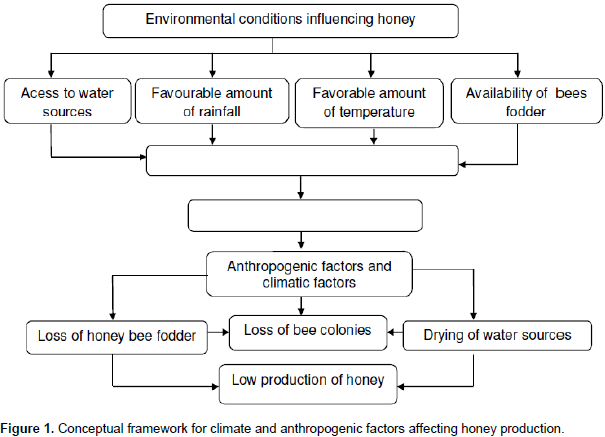
In this study, the anthropogenic and climate factors were assessed using parameters such as settlement establishment, charcoal-burning, farming activities, bush fires, fuel, temperature and amount of rainfall on honey production. Generally, unfavourable climatic conditions and anthropogenic activities threaten the availability of water sources, bee fodder sources and pollination services and, in effect, lead to low colonisation of bee hives. The study worked on the assumption that, disseminating awareness on the impacts of climatic and anthropogenic factors will contribute positively to honey producers engaging in environmental conservation practices and, therefore, increasing honey production in the process and sustaining the beekeepers’ livelihood.
Study area
Manyoni district lies from 6 to 7° South and 34 35° East of Greenwich Meridian of Tanzania (Figure 2). This area covers 28,620 km2 about 58% of the Singida region [province] (DADP, 2007). The area is generally semi-arid and experiences very low rainfall with an annual average of 624 mm and short rains of about 49 days (Mary and Majule, 2009). According to Lema (2008), the mean annual temperature of the area is 21.5°C; however, there are altitude-related variations. The annual mean, maximum and minimum temperatures in the district are 22.0 and 24.4°C in November and 19.3°C in July (Mary and Majule, 2009). The district has a uni-modal rainfall type which begins in November and ends in April. The main vegetation cover for Manyoni district includes miombo woodlands, grasses, shrubs and thickets (District Agricultural Development Plan (DADP), 2007).
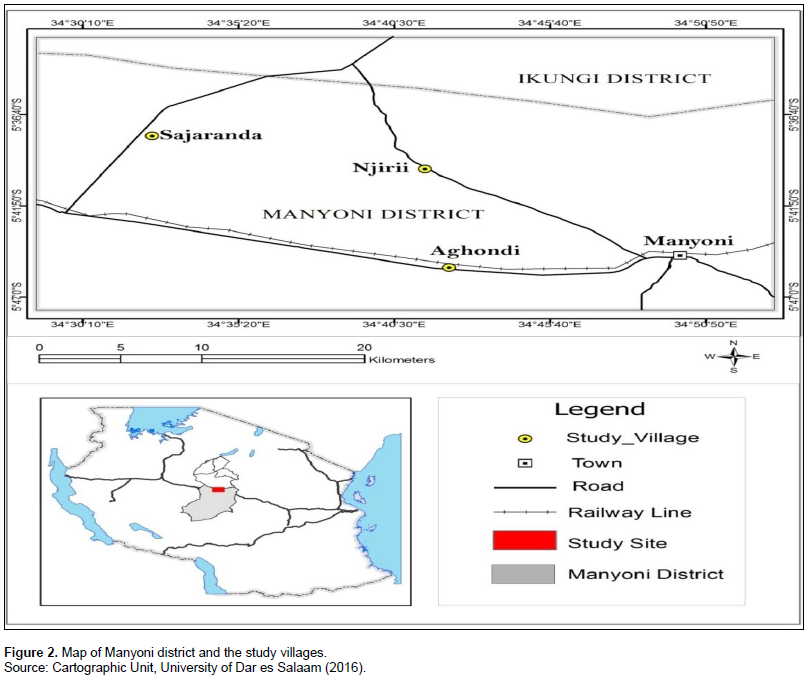
Types and methods of data collection
Secondary data were collected through documentary review of books, published articles, journals, and government reports. The documents reviewed were obtained from the Forest and Beekeeping Division (FBD) Offices in Manyoni, the Institute of Resource Assessment (IRA) and electronic resources. Primary data were collected from three villages, namely Sanjaranda, Aghonde and Njirii. The selection of villages was based on their experiences in beekeeping activities and honey production levels. From the selected villages, about 107 participants were selected to fill in survey questionnaires. And about 63 respondents were purposively selected for face to face interviews. Each village had 21 respondents. Similarly, the beekeeping officers from Manyoni District Executive District, the Tanzania Forest Services (TFS) - Manyoni Offices and other key relevant officers were for data gathering. Nature and type of data collected included the characteristics of the sampled beekeepers, economic profile, anthropogenic and natural causes of environmental degradation and the impacts of environmental degradation on beekeeping activities. Primary data were collected using structured questionnaires (for households) and interviews with key informant (beekeeping officers in Manyoni). Data were collected between February and May 2016.
Data analysis
Data from questionnaires were coded and entered using STATA (Version 12) computer software. Data in STATA were finally analysed using descriptive statistics and regression analysis. A linear regression model was used to assess how both anthropogenic and climatic factors reduce honey production using five variables which included impacts of low rainfall, wild fires, settlement establishment, livestock grazing and farming activities. The level of significance was tested using t-test at 5% level of significance. A linear regression model for the factors that cause low honey production was specified as follows:
Y = α0 + α 1X1 + α 2X2 + α 3X3 + α 4X4 + α 5X5 + ε
Where:
Y = Honey harvesting per hive (kg)
α0 = The intercept of regression equation
α (1-5) = Coefficient of parameter estimates
X1 = Quantity of rainfall (in mm)
X2 = Fire setting (ha)
X3 = Establishment of settlements (in ha)
X4= Livestock grazing (in ha)
X5= Farming activities (in ha)
ε = Error term
Characteristics of sampled beekeepers
Age of the respondents
About 52.8% of the respondents were aged between 41 and 60 years followed by those aged 21 to 40 years who formed (37.6%) of the respondents (Figure 3). The low number of beekeepers aged below 20 years could be explained by the fact that majority in this age-group do not have enough beekeeping skills. Moreover, most of the members of this group were still pursuing either primary or secondary school education. Generally that there is large number of respondents suggests that they were mature enough to comprehend and provide correct information required for research questions given.
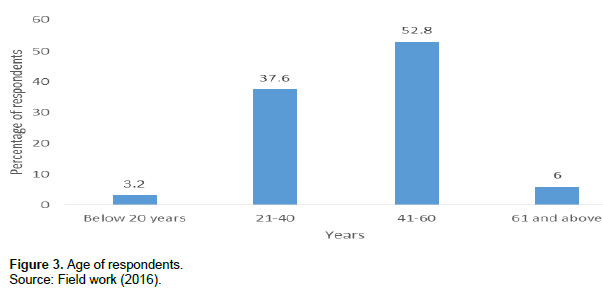
Education of the respondents
About 93.5% of the beekeepers had completed primary education followed by 3.7 and 1.9% with secondary education and non-formal education, respectively (Table 1). This level of education might affect capacity to access to knowledge and skills about beekeeping and environmental management. Additionally, this low level of education may affect beekeepers capacity to manage, keep records of honey production and in searching for local and international markets.
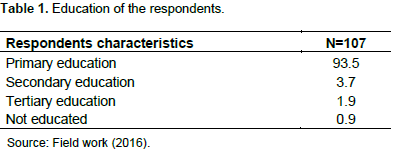
Economic activities
About 63.6% of the beekeepers who took part in the study depend on farming as their major livelihood activities, followed by 28.6 and 5% who rely on livestock-keeping and beekeeping activities, respectively (Figure 4). However, the majority of beekeepers reportedly engaged in more than one economic activity. These findings are similar to those of Mary and Majule (2009) who also found that farming was a leading economic activity in Manyoni district followed by beekeeping. Farmers in the area grow maize, sorghum, millet, beans and sunflower. A high proportion of petty businesses in all study villages was found to be associated with agricultural and livestock products. Such findings are not anticipated as over 75% of the rural Tanzania depends on agriculture for food and incomes.
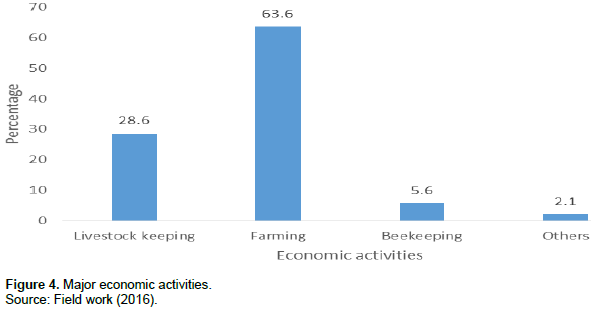
Decline in honey production in the study villages
Findings show that about 51 out of 63 (80.9%) of the interviewed beekeepers reported on the reduction of honey production in the study villages. The beekeepers moreover, stressed that there was decline in honey production if compared to years dated back in 1970s, 1980s and mid 1990s. Furthermore, about 41 out of 63 of the beekeepers (65.7%) reported they are currently harvesting honey between 3 to 6 kg per hive and between 8 to 15 kg per hive for log hives and top bar hive during high peak harvesting season respectively. These findings contradicts those reported by Namwata et al. (2013) that the average production of honey per hive in Balang’adu ward was about 12 to 20 kg during high peak season for top bar hives. According to URT (2001), the national average for honey production in Tanzania is less than 7 and 15 kg for log and top bar hives respectively.
With respect to this guideline, it is assumed that there is decline in honey production in the study areas probably due to the diverse negative environment changes. Besides, the findings suggest that the beginning of mid 1990s is marked with the beginning of decline in honey production in the study villages. Similar findings by
Lehébel-Péron et al
. (2016) reported that the period between 1970 and 2000 was a golden age for heather honey producers in Mont Lozere area, but after 2000 beekeepers experienced the decline of honey production caused by environmental changes. Generally it can be concluded that the decline in honey production is becoming a global challenge caused by various natural and induced factors.
Explanatory factors for the decline of honey production
Table 2 indicates recapitulation of both Traditional Ecological Knowledge (TEK) and scientific information relevant for determining the causes of reduction of honey production in the study villages. TEK is viewed as "library of information" acquired and transferred by local people throughout generations to describe diverse ecological settings (Brush, 1993; Berkes et al
., 2000). It is important to note that local beekeepers are also endowed with empirical knowledge and experiences about beekeeping activities and their local environment (
Lehébel-Péron et al
., 2016). This study selected four anthropogenic and natural factors to explain their linkages to reduction of honey production in Manyoni area. These were; loss of honey bee colonisation, drying of water sources, loss of foraging plants and climate change. In fact, this is an indication that local beekeepers in Manyoni district were able to signal and probably adapt or cope with dynamic environmental changes that reduce honey production.

Factors threatening honey production
Loss of bee colonies
Regarding hive colonisation, 48.6% of the respondents reported that about three-quarters of their beehives were colonised, followed by those 27.1% who reported that all their beehives were colonised and 20.6% reported that half of their beehives were not colonised (Figure 5). The findings show that the loss of honey bee colonies was common in the study villages; however, the situation was not experienced by all the respondents. The loss of honey bee colonies observed suggests that either honey bees were absconding or the beehives were not colonised. This circumstance could be caused by a number of factors such as harsh climatic conditions, anthropogenic activities, diseases and predators such as honey burger and ants (Godfrey, 2015). These factors normally cause the foraging areas to attract fewer honeybees in apiaries. For beekeepers, the loss of bee colonies have implication for the diminishing of beekeeping activities and may lead to low income due to low production of honey and other bee products. For beekeeping areas, the loss of bee colonies indicates that there are few conservation practices in the area and consequently, environmental degradation. Similar results were reported by Kugonza et al. (2009) in that high temperature, low rainfall, type of hives in use and lack of shade were factors reducing the rate of honeybee colonisation while increasing the rate of honeybee absconding in Uganda. On the other hand, Babarinde et al. (2015) and Baylis et al. (2015) argue that excessive use of pesticides could be the most widely spread practice behind the loss of honey bee colonies.
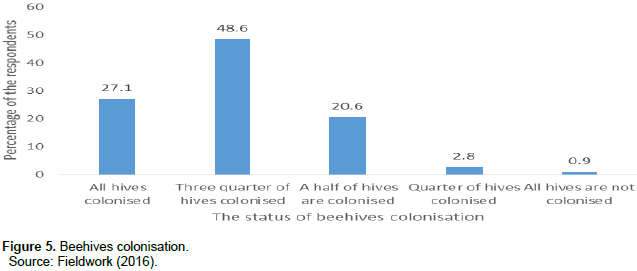
Drying of water sources
Results from interviews indicate that about 47 out of 61 of the respondents (77%) in the study area experienced unprecedented drying of water sources such as wells, ponds, streams and water in valley bottoms (Figure 6). Also, more frequently, the respondents reported experiencing the drying of water sources mostly from May to December and associated them with increasing human activities Furthermore, the respondents revealed that few beekeepers have managed to build water reservoirs near the apiaries as an adaptation strategy to the water shortage problem. These findings signify the observation that the drying of water sources was probably caused by the degradation of the environment often triggered by human activities such as deforestation, shifting cultivation, browsing activities and others.
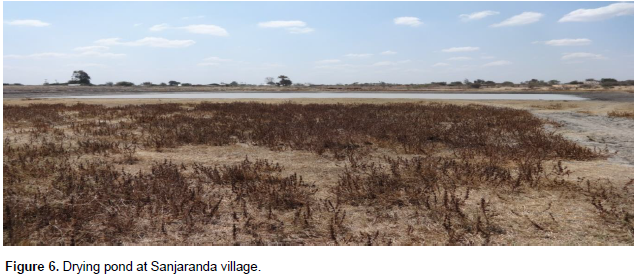
The environmental degradation occurring in the area implies that the depletion of landscape cover, which in turn leads to the inability of soils to retain water and refill the ponds, streams and valley bottoms, especially during the dry season. The drying of water sources could also be attributed to the unpredictable rainfall experienced in the area caused by climate change. Unpredictable rainfall entails that the low amount of rainfall received in the study area was unable to replenish the water sources available. Similar results were reported by Chokkalingam (2004), who found that the shortage of rainfall particularly in arid and semi-arid (ASAL) areas have impacts on environmental resources including the drying of water resources. In the study area, the drying of water sources had impact on the socio-economic activities including beekeeping because honey bees require water to process stores, make brood food and hatch eggs (Garvey, 2013). Indeed, bees forage for water at almost any source near their colonies (Ellis, 2010). The implication is that proper environmental conservation enables the protection of vital water sources.
Loss of foraging plants
About 60.7% of the respondents reported that the loss of floral sources was moderate followed by 30.9% who perceived the loss as severe and only 8.7% did not see any loss of floral sources (Table 3). Moreover, interview results indicate that the participants described the loss of floral sources in terms of loss of vegetation cover. The participants narrated that some areas in the study villages had completely lost their vegetation cover, particularly the Itigi thickets. These findings indicate that beekeepers were familiar with the loss of bee foraging areas; however, the majority perceived this loss had little impact on the honey production. Again the loss of foraging plants is possibly linked to increasing human activities in the area. In other words, this may suggest little initiative have been taken to protect and conserve the environment. Comparable results were reported by Makero and Kashaigili (2016) that Itigi area has been losing vegetation cover, which has dropped from about 345,150.5 ha in 1991 to 313,451 ha in 2000 and 293,444.3 ha in 2011, a decline by 11% and 15% respectively. The implication is that the area is losing important foraging plant species that contributes to honey production.
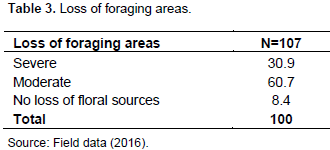
Impact of anthropogenic and climate factors on honey production
Anthropogenic activities
Based on data generated from household surveys carried out in all the study villages, the study was able to establish that the anthropogenic activities that contributed to the reduction of honey production were highly diverse. The respondents ranked in the order of impacts as follows: farming activities (33.6%), grazing (23.4%), charcoal-burning (13.1%) and bushfires (11.2%) (Figure 7). Other factors mentioned were, settlements and fuel wood.
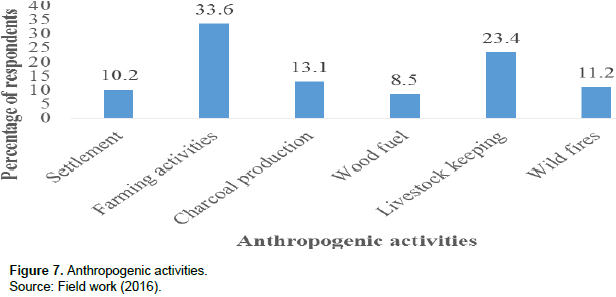
Increased farming activities
In the study villages, farming was a major source of both food and income. The activity has contributed to the increase of areas for cultivation which leads to deforestation and environmental degradation. The loss of forests tends to reduce water sources, nesting areas and fodder for bees and, consequently, affects the production of honey. Similar results were reported by Kaale et al. (2002) who found that inappropriate agricultural practices were major threats to forests and, therefore, contributed to the reduction of beekeeping activities and honey production. Additionally, agricultural practices use agro-chemicals that threaten beekeeping activities (Klein et al., 2007). However, studies by Kovács (2010) and Vaughan et al. (2015) show that flowering crops contribute significantly to enhanced honey production. Kovács (2010), for example, reported that honey collected from farms (oil crops) contributed to about 40% of the total honey produced in Hungary. In other words, despite an increase in farming activities flowering crops grown in the study area such as sunflower, leguminous plants and maize can contribute to honey production. However, it was difficult to ascertain this through empirical data.
Increased grazing activities
The findings further affirm that livestock-keeping was an important economic activity albeit with impacts on the environment and honey production. The impacts caused by browsing activities suggest that there was an increase of livestock than the resources available. The increase of livestock population in the study area could be linked to the migration of pastoralists searching for green pastures and water to feed their livestock. The need for water and pastures had increased pressure on the beekeeping areas, therefore, threatening bees’ foraging resources such as water and floral plants. Comparable results were reported by Makero and Kashaigili (2016), that grazing was one of the activities contributing to the degradation of land cover at Itigi. According to IFAD (1998), grazing pressure is the primary cause of land degradation, which affects plant cover in semi-arid areas. Yanda and Madulu (2005) found that passing many cattle in the area was the main cause of degrading vegetation cover in many parts of Tanzania. A study by
Lehébel-Péron et al
. (2016) found that the increase of cows to replace sheep in Mont Lozere had detrimental impacts on the compaction of soils which also hinders the growth of heather plant, thus, leading to reduction of heather honey production. This signifies that the increase in browsing practices in beekeeping areas also had negative impacts on the floral sources, thereby reducing honey production in all the study villages.
Increased charcoal-burning
Charcoal-burning is another factor that was reported to contribute towards the reduction of honey production in the study area. The production of charcoal was found to be an important alternative source for both income and energy. The increase in charcoal-burning activity it is due to high demand for charcoal in both rural and urban areas. Inevitably, wanton felling of trees for charcoal-burning has had significant impacts on forests and thickets, which have been cleared for this activity; thereby diminishing floral sources for honey production. Similarly, DW (2015) reported that charcoal-burning was one of the human activities threatening honey production in semi-arid regions of Tanzania. A recent study by Ministry of Natural Resources and Tourism (MNRT) (2015) found that Tanzania was losing about 372,871 ha of forest per annum caused human activities. It is estimated that between 100,000 and 125,000 ha of forest is lost annually as a result of charcoal-burning in Tanzania (World Bank, 2009). Sedano et al. (2016) found that the high demand for charcoal in urban areas is the main driver of forest degradation in most Sub-Saharan Africa. This evidence attests to charcoal-burning constituting a primary threat to the forest resources, which was contributed to the reduction of honey production in most beekeeping areas. However, the monitoring of the loss of beekeeping areas in Tanzania is not easy because a large part of land and forest resources are owned under a communal mode.
Increased bush burning
Bush burning was also given priority by the respondents as one of the factors affecting honey production in the study area. The frequencies of bushfire in the study area, particularly late burning, are probably caused by activities such as farm preparation, beekeeping activities and hunting. As a result, bushfires contributed to the destruction of the vegetation cover, thereby threatening floral sources, killing honey bees and burning hives. Similar results were reported by Chigere (2014) that bushfire normally kills bees, destroys beehives in apiaries, destroys floral sources and, therefore, contributes to low honey production. Similar findings were also reported by Ahrends (2005) in that bushfires were common environmental hazards affecting the vegetation cover in Savannah areas of Tanzania. Fire setting was also reported by Almond (2000) and Makero and Kashaigili (2016) as a threat to Itigi thickets. In other words, beekeeping activities in the study areas are threatened by bushfires as manifested by low honey production in the study area.
Climate factors
Beekeepers were also asked to indicate their perception and understanding of the impact of climate change on honey production. About 63.5% and 13.1% of the beekeepers perceived low amount of rainfall received and temperature to have impacts to the low honey production (Table 4). Similar findings were reported by participants during interview sessions in focus groups to the effect that the shortage of rainfall had a greater impact on low honey production than the temperature in the area. The empirical study by Mary and Majule (2009) also indicates that the area receives low amounts of rainfall.

Unpredictable rainfall
Honey production depends on rainfall, as it boosts the thriving of flowering plants from which bees collect nectar and pollen. Rainfall also provides drinking water for honey bees. The diminishing of these resources reduces foraging for nectar and water and, consequently leads to the low production of honey. In addition, the shortage of rainfall makes the area unfavourable for beekeeping activities, which in turn increases the likelihood of the honey bee colonies to abscond. Moreover, this absconding of bee colonies as a result of the shortage of rainfall may lead to low honey production. Comparable findings were reported by Berhe et al. (2013), Schweitzer et al. (2013) and Alemu (2015), all found that the shortage of rainfall had impacts on honey production as it reduced foraging activities, water resources and dilution of nectar, hence consequently weakening the honey bee colonies.
The shortage of rainfall in beekeeping areas may also lead to the change of flowering seasons and loss of pollinators for about 17 to 50% of bees (Mommett et al., 2007). Furthermore, according to Garvey (2013), unpredictable rainfall normally limits the bees’ capacity to process, store, make brood, and hatch eggs. For example, low production of heather honey in France experienced in years of 2000s is a typical example explains the impacts of increased frequency of droughts and other unpredictable weather from the area (
Lehébel-Péron et al
., 2016). Manyoni area also faces the shortage of rainfall problem as confirmed by empirical data that the area receives about 624mm of rainfall per year. Yet, the reliable amount of rainfall for beekeeping activities is supposed to range from 750 to 900 mm, particularly in all areas practicing traditional beekeeping (Kumar et al., 2014).
Increased temperature
The study findings show that temperature had a comparatively lower impact on honey production than the effect of low amounts of rainfall. The available amount of temperature had minimal impacts on the thriving of honey bees in the area. Activities such as bees’ visitation for foraging nectar, pollen and water were not affected by temperature. Moreover, honey bee colonies in hives were not threatened by temperature. The findings indicate that the amount of temperature in Manyoni area was appropriate for supporting honey production. Lema (2008) reported that the minimum and maximum temperature in Manyoni area is about 19°C and maximum of 24.4°C in July and November, respectively. The ideal daily temperature for bees to work effectively ranges from 10 to 30°C (Jocić, 2000; Alattal and Alghamdi, 2015). Temperatures of below 10°C or above 40°C reduce the bees’ visitation and honey collection (Puškadija, 2007). Thus, it can be deduced that the amount of temperature available in Manyoni area had less impacts on beekeeping activities and honey production.
Regression analysis for anthropogenic and climate factors affecting honey production
A regression analysis was run to determine the significance of the determinant factors inducing low honey production. The dependent variables were farming activities, grazing activities, settlement establishment, bushfires and low rainfall (Table 4). With regard to the parameters the statistical tests of the results from the model were significant at P<1% and P<5%. Through its R-square value, the model shows that 41% was explained by environmental threats affecting honey production due to predictors and the remaining 59% was caused by predictors not included in the model. This suggests that an increase in environmental threats caused by anthropogenic and climate factors will increase the likelihood of beekeepers harvesting little amounts of honey because environmental threats are likely to reduce water, nesting areas and fodder for honey bees. With regard to predictors influencing low honey production, the results indicate that two (low rainfall and fire setting) out of five parameters (Table 5) examined significantly influence low production of honey in the study area.

Also, the impact of low amount of rainfall in the study area had a direct and positive relationship with the low production of honey and it was statistically significant at P<1% as indicated in Table 5. This means that as the rainfall declines the production of honey also decline. Favourable quantity of rainfall increases fodder and water for bees and enables them to make brood food, hatch eggs, increases nutritional quality of honey and maintains flowering seasons (Garvey, 2013). Further, it increases pollination services and reduces bees absconding (Mommett et al., 2007; Berhe et al., 2013; Stocksad, 2007). Fire setting, particularly late burning had negative relationship with production of honey and was statistically significant at P<5% (Table 5). Negative and inverse relationship indicates that as bushfire outbreaks increases within the beekeeping areas, lower honey is produced. To increase honey production, awareness on environmental conservation and penalties should be promoted in study villages to foster responsible habits. Furthermore, fire setting will affect honey production as they are inversely related.
The result also indicates that the establishment of settlements had inverse relationship with honey production in that the higher the rate of settlements the low the honey production but was not statistically significant. This entails that an increase in settlements was significant in increasing human population in the beekeeping area, thereby increasing deforestation and affecting bee’s habitat. Also that, governmental agencies such as the Tanzania Forest Services (TFS), local government authorities at the district level, the Forest and Beekeeping Division, non-governmental organisations (NGOs) and other relevant stakeholders were less effective in addressing concern on the threats that were caused by the establishment of settlement particularly in forested areas. Livestock grazing also had negative relationship with the honey production but was statistically non-significant (Table 5) which implies that as grazing rate increases there is reduction in the number of beekeeping activities and, hence, lead to low honey production and vice-versa.
Like in the case of bushfire, this negative relationship shows that the increase of grazing activities is expected to degrade the environment, and eventually reduce honey production. Otherwise, factors such as destocking, establishment of ranching, awareness creation and penalty are intensively practised in the study area. Additionally, livestock-keeping is anticipated to cause low honey production as they are inversely related. Farming activities had positive relationship with the production of honey but was not statistically significant. This infers that land clearance for increasing farming activities was not necessarily negatively affecting honey production in the study area. In fact, farming activities have been contributing to honey production because it provides nectar sources. Indeed, beekeepers were found to be placing their beehives near the farms of particularly sunflower to enhance both pollination and honey production. This means, environmentally-friendly agricultural practices do not necessarily lower honey production. However, where farming involves a lot of agrochemicals application, it could affect honey production through destruction of some biodiversity relevant for beekeeping.